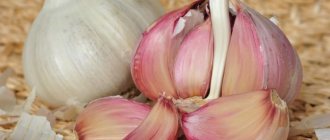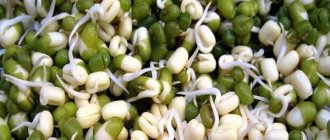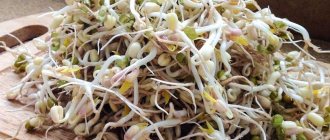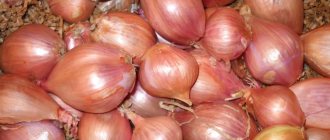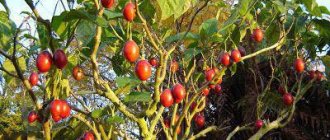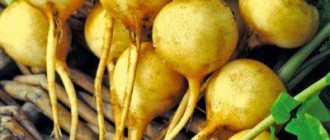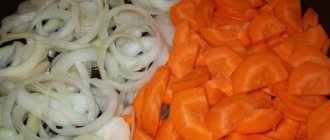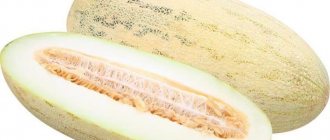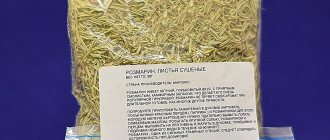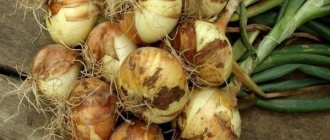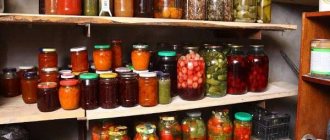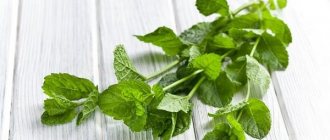Dried onions: features and benefits
Although it may seem to many that drying onions is a modern method of preparing vegetable products, this method has been successfully used for more than one millennium. Thus, it is known that the product in this form was very popular among the ancient Romans. The interest of modern consumers in dried spices is explained by the presence of several important advantages:
- a vegetable that has undergone this treatment does not rot or mold;
- in cooking, such a product can be used without restrictions;
- the total mass of the final product is reduced by 5 times, and the volume by 10 times compared to fresh onions;
- Dried onions do not require special storage conditions.
Terms and conditions of storage
Any dried product is characterized by an increased ability to absorb moisture , and onions are no exception. High humidity in the storage area causes the development of rot and mold; such a product can no longer be eaten.
Attention! Large volumes of dried onions - more than 1 kg - are stored in a cool, ventilated place, such as a basement or cellar. Humidity in the room should be moderate, no more than 70%.
Vegetables dried for winter storage, chopped onion or green, are stored in plastic or glass containers with lids. Cardboard boxes and paper bags are also used as packaging. It is preferable to use small containers.
The packaged product is placed in a cool, dry place out of direct sunlight . For daily use, it is convenient to pour the seasoning into jars with a tight-fitting lid. Small volumes are well stored in the kitchen (in a closet or bedside table).
Advice. Place a fabric bag with rice in the container with the dry product - it absorbs moisture well.
Whole pieces of dried onion, if stored properly, are suitable for use for two years . But in ground form, the seasoning quickly fizzles out and loses its taste. For this reason, it is advisable to grind onions in small quantities before use.
Types of dried onions
If you are going to transform the usual onion heads into a more ergonomic shape, you should know the basic techniques of the process:
- Drying using a special drum is considered the simplest option. This processing method is characterized by exposure of the crushed product to hot air.
- Spraying powder. The method is used to obtain a powder concentrate by spraying crushed raw materials in the air. Although such a product is very convenient to use, as a result of such processing, almost all essential components evaporate.
- Freeze drying is considered the safest, although very time-consuming, option. The technology consists of freezing prepared raw materials and then vacuumizing them. This means that the moisture contained in the raw product immediately passes into a gaseous state, bypassing the liquid fraction. During this processing, only volatile compounds, that is, esters, are lost. When soaked, freeze-dried spice exhibits exactly the same taste and aroma qualities as a fresh vegetable.
Dried onion seasoning is ideal for preparing a variety of dishes, including even baking. Fried and baked vegetables have a much smaller scope of application.
Using dried onions
In dried form, the spice is used in the preparation of a wide variety of dishes. It perfectly complements vegetable, mushroom, meat, fish dishes, and goes well with savory delicacies. Dried vegetables can be an excellent replacement for fresh ones.
We recommend that you find out whether onions can be frozen.
Typically it is used:
- in salads;
- in soups;
- in second courses;
- in marinades;
- in pies;
- in minced meat;
- in sandwiches;
- in snacks;
- in conservation;
- in some desserts.
Dried onions are a useful vitamin seasoning. For a long time, it does not lose its properties: neither taste, nor aroma, nor useful. Therefore, if there are no contraindications, you can safely add spice to any dishes.
Chemical composition of spice
When planning to choose the optimal option for drying onions, you must take into account the degree of dehydration of the product for each individual processing method. It is better to give preference to the technique that allows you to preserve as much as possible all the useful components of the onion.
The dried product, like fresh root vegetables, contains the following groups of useful substances:
- Vitamin complex . These are ascorbic and nicotinic acid, tocopherol and almost completely vitamin group “B”.
- Minerals . Onions are rich in substances beneficial to the body such as phosphorus, zinc, selenium, manganese, and sodium.
If the drying technology is followed, the composition of the resulting spice is practically no different from the composition of the original product. Only the concentration of useful elements increases due to the loss of liquid from the product.
In the oven
- Peel and cut the onion into rings no more than 5 mm thick.
- Line baking sheets with parchment paper in advance and place the pieces on them in one layer. There must be free space between the rings, otherwise they may stick together during drying.
- Preheat the oven to +70 °C and place the onions in there, while opening the door slightly. Make sure that the temperature does not rise, otherwise you risk burning the workpieces.
Oven drying may take up to 8 hours. If you overexpose the product, it will change color greatly. This can be avoided by first soaking the pieces in a saline solution. Dilute 50 g of salt in 1 liter of cold water and keep the onions there for 5 minutes.
To dry the onion faster, immerse the chopped rings in boiling water for 2 minutes. After this, place them in the oven at +70 °C for 2 hours. Then reduce the temperature to +40 °C and keep it there for another 1 hour. Constantly turn the onion over and remove any dry pieces.
Benefits of dried seasoning
Since dried onions retain the entire set of useful components listed above, its effect on the body is manifested in the following positive actions:
- strengthens the immune system;
- stabilizes blood pressure;
- thins and removes mucus;
- has a weak laxative effect;
- helps with various types of vitamin deficiency;
- promotes the removal of excess fluid;
- normalizes blood circulation;
- improves digestion;
- stimulates the production of liver secretions.
The presence of small portions of dried onions will have a beneficial effect on the functioning of the entire body and will become an effective preventative against colds.
Chemical composition and calorie content of dried green onions
Dried onions contain glycosides, pectins, and phytoncides. The product is rich in vitamins A, E, K, C, thiamine, riboflavin. It is extremely beneficial for the eyes, heart, blood vessels, improves immunity, and fights inflammatory processes in the body.
| Macronutrients | Microelements |
| Potassium | Bor |
| Sodium | Iodine |
| Sulfur | Manganese |
| Chlorine | Kolbat |
| Phosphorus | Zinc |
| Silicon | Fluorine |
| Calcium | Chromium |
| Copper | |
| Iron |
The energy value is on average 218 kcal per 100 g. The calorie content depends on the humidity, the variety used, and the maturity of the plant. In any case, the workpiece is light in weight. There is no more than 10 g in a tablespoon. And this amount is enough for a whole pan of soup or a large casserole. Therefore, the product can be safely added to any dish without worrying about your figure. You can also freeze green onions or store onion feathers fresh.
How do you prepare green onions?
DryingFreezing
Green onions can be dried in the fresh air, in a microwave, in an oven, or in a special electric dryer. Only healthy, fresh feathers are used. Shelf life: 24 months.
Contraindications
But if you want to enrich your diet by including dried onions, you need to take into account contraindications for use. You cannot use the spice in this form in the following cases:
- during pregnancy and breastfeeding;
- in the presence of lesions of the oral mucosa;
- persons with gastrointestinal pathologies;
- patients suffering from pancreatitis;
- for bronchial asthma;
- those who have liver problems;
- in case of individual intolerance to the product.
As you can see, the list of restrictions on the use of dried onion spice is very extensive. Therefore, to eliminate possible health risks, it is better to consult a doctor about the use of such a controversial product.
What are the benefits of dried product?
What are the benefits of dried product? Its benefits are presented as follows:
Despite the enormous benefits of onions, harm from its use is still possible.
Gastroenterologists include the following main contraindications:
- Lactation period in women. If you ignore the recommendation not to eat dry onions during this period, the newborn may refuse mother's milk.
- Pregnancy. During this period, the fair sex should eat fruits and vegetables, as well as protein foods. You should also consult your doctor regarding your desire to use any seasonings in your food. When eaten fresh, the vegetable is very healthy and is even indicated for pregnant women due to its significant folic acid content, but when dried it should be avoided.
- Oral diseases. Onions can cause irritation to the mucous membranes. In the presence of caries and periodontal disease, the vegetable can increase bad breath.
- Pancreatitis. Seasonings in the diet are unacceptable, as their use can be fatal.
- Diseases of the gastrointestinal tract, especially ulcers. Dried onions are taboo, because they are classified as spicy seasonings.
- Certain forms of gastritis (especially with high acidity). Dried onions irritate the stomach walls and can cause belching, heartburn and epigastric pain.
- Liver diseases. If you have any liver disease, adding dried onions to your diet is not allowed.
- Bronchial asthma. In addition to dried onions, you need to exclude dairy products, confectionery treats, pasta, a significant portion of fish varieties, fruit-based yoghurts, and eggs from your diet.
- Allergic reaction. It becomes a consequence of individual intolerance and can manifest itself in different ways. With significant consumption of dry onions, there is a high probability of developing pulmonary edema, suffocation and even urgent hospitalization.
What types of onions can be dried
Onions are not only the usual heads of a spicy vegetable or green fragrant feathers that we gladly add to food. The onion family includes many different species. Moreover, not every type of onion is suitable for drying. Therefore, it is worth remembering those varieties that can be safely subjected to such processing:
- Onion - Batun , better known as summer onion. This variety does not form bulbs, but has very powerful stems.
- Onions are considered the most common variety. Depending on the variety, the heads can be colored from white to purple.
- Leek. This is also a familiar variety. Dried leeks have a very pleasant aroma and rich flavor bouquet. Interestingly, only the leaves and stem are eaten, although this species has well-formed heads.
- The Shnit variety has an elegant taste, but its leaves are very small. But such onions can be harvested several times a season.
- Shallots are also a very popular onion variety, which attracts people with their very juicy bulbs.
- Slime does not form bulbs. But its juicy foliage with a pungent flavor is highly valued in cooking. The aroma of this type of onion is very similar to garlic.
- Jusayem or branched onion is considered an exotic variety for our latitudes. But the dried product is great for meat and fish; it is added to pies and side dishes.
Choosing onions for drying
Due to its popularity, many housewives try to stock up onions for the winter so that they can use them all year round. Dried vegetables in general and dried onions in particular are an ideal solution for those who want to preserve food. In principle, if the onion is properly grown, on time and correctly harvested, under certain conditions it can be stored without additional processing, and yet it is much easier to store and use dried onions. The production of such onions sometimes takes a lot of time and requires a separate room, because during the drying process they emit an unpleasant odor.
Another thing is the dryer. It makes it possible to dry onions quickly and without negative consequences, maintaining the ideal temperature regime.
When choosing onions for drying, you should give preference to hard, elongated onions of sharp varieties. They must be ripe, washed and well dried. Usually preference is given to varieties such as Krasnodar or Strigunovsky, although others can be used.
Home drying methods
After familiarizing yourself with the features of the product, you can begin to study the technology itself. By the way, regardless of the harvesting method, there is a preparatory stage that is almost the same for different drying options. Therefore, before drying onions, you must first prepare the material.
- For drying, it is necessary to select healthy specimens without signs of rot. Moreover, the bulbs should be well dried in the sun.
- The selected heads should be crushed: they can be cut into slices or half rings.
- The prepared semi-finished product is laid out on a baking sheet or clean sheets of cardboard.
- If the onion is air dried naturally, it needs to be stirred periodically.
- When the workpieces acquire elasticity and a golden hue, the finished material must be placed in a container.
- Air drying takes about two weeks on average.
Drying in the oven helps save time. Preparation is similar to the first method. The technique differs only in that the workpiece is laid out on a baking sheet, which is then sent to the oven for two hours. Drying is carried out at a temperature of 45-50 C.
The best option is to process onions in an electric dryer or microwave. This method guarantees maximum preservation of nutrients and significant time savings. True, this method is relevant when you need to dry a small amount of raw materials.
Many modern housewives dry onions in an air fryer. This procedure takes no more than an hour if you select the maximum speed of the hot air jet.
If you strictly adhere to the technology of the chosen onion drying method, the finished product will retain its quality for two years.
Drying technology
Since drying requires a lot of space, it is convenient to dry turnips in portions of 3-4 kg . Let's talk about the intricacies of the process in more detail.
What is necessary
To prepare a tasty and healthy product, you only need fresh onions , collected from the garden or purchased in a store. There is no need to add any preservatives for preservation.
Onion preparation
Fresh onions are peeled from dry scales and chopped by hand or using a food processor . Cut the vegetable into rings, half rings or cubes. It is worth considering that the larger the pieces, the longer they will dry.
Drying
The prepared product is distributed on baking sheets or racks and, depending on the chosen drying method, placed in a preheated oven, electric dryer or air fryer. Or air dry in a ventilated place.
During the drying process using any of the selected methods, the onions are periodically stirred and checked for readiness. The finished product has a pleasant caramel color, becomes fragile and aromatic.
Take note:
How to pickle red onions
How to make pickled leeks
How to salt green onions for the winter
How to properly dry onions in an electric dryer?
An electric dryer is an indispensable thing for those people who save space in the freezer and prefer to dry most of their food for the winter.
If you have nowhere to store onions and leeks, you can dry them perfectly.
This can be done either in the oven or in an electric dryer.
But an electric dryer produces a higher-quality product, which is pleasant to use later in cooking.
For drying, onions need to be peeled, the tails cut off on both sides, washed and dried with a towel, then cut into rings and disassemble the rings with your hands.
After this, if you want your meadow not to be too spicy, you also need to rinse it with cold water.
If you like the spiciness and slight bitterness of onions, there is no need to rinse them.
Dry the washed onions properly again.
Then put the onions in an electric dryer, trying not to have too much of it. After this, turn on the electric dryer; depending on the recommendations of your model, the temperature may be approximately 50 degrees. The onions are dried during the day.
An electric dryer produces dried onions. In fact, it resembles dried, but when placed in a humid environment, it quickly gains moisture.
Here's how to dry onions:
- Peel off the husk
- Wash
- Cut the onion into slices 3-4mm thick
- Place evenly into trays.
You need to dry for 2.5 hours at a temperature of 70 degrees, 4 hours at a temperature of 50-60 degrees.
Every half hour we swap the top and bottom pallets, do the same with the second and fourth pallets, leaving the middle one in place. This is with a 5-tray dryer.
If there are 6 or 4 pallets, then swap the 1st and 6th (1st and 4th), 2nd and 5th (2nd and 3rd), 3rd and 4th respectively.
Dried onions are a wonderful seasoning that will add flavor and enhance flavor to any dish. This homemade spice can be prepared at home. So, in order to dry onions in an electric dryer , you need to peel and wash the onions, which we then thoroughly dry on a paper towel.
After this, cut the onion into large rings or half rings, and then rinse it under running water to get rid of films and excess onion juice. Place the washed onion in a colander and let the water drain, then place it on a towel and dry.
Place the prepared onions on the trays of the electric dryer, but not in a very thick layer so that there is space between the rings.
We set the required temperature on the electric dryer, it can vary from 50 to 70 degrees, and drying the onions itself will take about 8 hours, but you will need to periodically check them, mix them and change the trays.
Such dried onions can be used as an independent seasoning, adding it to soups, goulash, sauces, etc. But you can also prepare a universal homemade seasoning; you just need to add dried herbs, sweet peppers, and carrots to the dried onions - this will be an excellent soup seasoning without harmful ingredients.
Preparing onions for drying and storage
Long-term storage of plants will be guaranteed by:
- Proper cleaning;
- Preparation for storage.
The first step is proper cleaning. Harvesting should begin when most of the bulbs have ripened, the tops have turned yellow and fallen, and the necks at the base have become dry. Cleaning is best done in clear weather.
ATTENTION: The bulbs must not be pulled out, beaten or thrown on the ground - this will cause mechanical injuries! It is recommended to carefully dig up and stack the bulbs.
Step two – preparation for storage! Only dense, juicy bulbs without mold or damage should be stored for storage. The surface must be completely dry. The husk should fit snugly and completely envelop the onion.
It is important to pay attention to the ponytails - they should be completely dry, and the warping around the ponytail should be firm.
Methods for preparing chopped onions for the winter
To dry the onion quickly and evenly, you need to prepare it - peel it and cut it into rings, half rings, feathers, cubes. The main thing is that the thickness of the plate of the dried product is no more than 5 mm and the sliced particles do not vary too much in size.
Drying in the fresh air
The easiest way to prepare winter preparations. For drying, choose a shaded place with good ventilation.
- The cut pieces are laid out on planks, cardboard, spread cotton cloth, paper without printing ink.
- As the semi-finished product withers and dries, it is necessary to stir it to ensure uniform access of fresh air.
- After approximately 10-14 days, the onions are ready for storage.
A properly dried vegetable has no traces of mold (black spots) and has an elastic consistency.
In an electric dryer
The use of a household electric dryer significantly speeds up the onion drying process compared to the natural process in the open air.
- Cut into rings or slices and place loosely on a wire rack.
- The thermostat must be set to a temperature of 55-60 °C.
- During the drying process, the trays are periodically swapped to ensure uniform preparation of the semi-finished product.
- Depending on the source raw material (cutting method, variety, moisture content in the product) and the design of the dryer, onions dry from 5 to 7 hours.
Dried onions: benefits and harms, how to use, how to dry at home, photo
Onions and green onions are popular seasonings for various dishes in many cuisines around the world. Even those who do not like this spicy seasoning often want to give their dishes a more pronounced taste and aroma with its help. For such consumers, there is an excellent alternative to fresh vegetables - dried. How to prepare this type of spice is described below.
Description and features of dried onions
You can prepare dried onions yourself or purchase them ready-made in different fractions. Vegetables prepared on an industrial scale come in two grades: first and highest. The main difference between them is the color of the final product.
All types of dried onions are prepared in several ways:
- Using a tumble dryer. This is the simplest option for drying vegetables. The crushed product is loaded into the drum and blown with a stream of hot air.
- Spraying powder. Chopped onions are sprayed in a stream of air. This drying option is usually used to prepare powder, such as garlic. Although the product turns almost into dust, which is suitable for many consumers, it loses almost all the essential oils and beneficial components. The finished product may be white or golden in color. The latter option is possible if the processing is carried out with too hot air - partial caramelization of the sugar will occur.
- Freeze drying. This option is expensive, but the safest for vegetables, in the sense that it retains all the beneficial substances. The technology of the method is as follows: freezing followed by vacuumization. Moreover, the vacuumization process takes place in such a way that the water inherent in the vegetable passes from a solid state to a gaseous state, bypassing the liquid state. During such processing, the product loses only volatile compounds.
Important! If you soak dried onions prepared by sublimation, you will get a product that has the taste and aroma of a fresh vegetable.
Comparing dried onions with other options for their preparation (frying, baking), it can be noted that they are the most useful product after a fresh vegetable. It is followed by the baked one, which loses a small amount of nutrients, as well as the pungency of taste.
In last place in terms of benefits for the body is fried, since it contains only a small part of the substances found in fresh vegetables. From the above we can conclude that the main difference between dried onions and baked and fried ones is the presence of useful substances.
They also differ in taste and use. For dried, it is not limited - it is suitable for almost all types of dishes: first, second, salads, baked goods. Fried is usually used with first courses and some second courses.
Baked - accompanies meat and vegetable dishes cooked in the oven.
The benefits and harms of dried onions
- Since when dried, onions completely retain the substances they contain, the range of their beneficial effects on the body is no less diverse than that of fresh ones:
- Strengthens the immune system.
- Has anthelmintic effect.
- A good therapeutic and preventive remedy for colds.
- Fights hypertension.
- Has an expectorant effect.
- Supports the body in diabetes.
- Stimulates the removal of excess fluid from the body.
- Has a laxative effect.
- Able to overcome scurvy.
- Fights hepatitis A.
- There is also harm from eating onions. It occurs if you neglect its contraindications:
- breastfeeding (babies may refuse breast milk);
- pregnancy (whether a particular pregnant woman can take this seasoning or not, the doctor must say);
- diseases of the oral cavity (the vegetable greatly irritates the mucous membranes and increases the signs of illness);
- pancreatitis (it is strictly forbidden, since the use of the product is fraught with death);
- gastrointestinal diseases (as it is a spicy seasoning);
- gastritis (the product irritates the walls of the stomach and causes very unpleasant sensations);
- liver problems;
- bronchial asthma;
- allergies due to individual intolerance.
What onions can be dried?
There are a huge number of varieties of onions - these are not just the usual turnips or green onions. However, not all of them are suitable for consumption, so the following can be dried:
- Onion. It is often called country or sandy. Refers to perennial plants. It has no bulbs, and the stems are very powerful. Greens grow until frost.
- Bulb. It has long tube-shaped leaves of a dark green color. The bulbs are large. Their color depends on the variety: it can be yellow, purple, white.
- Schnitt or skoroda. It has small leaves with a delicate taste. The harvest is harvested more than once per season.
- Shallot or magpie, bushweed. It has small light purple or white, oval or round bulbs, very juicy and soft. The foliage is narrow, long, delicate.
- Slime. The owner of ribbon, island and succulent foliage. Does not form bulbs. The aroma is similar to garlic.
- Leek. It has bulbs, but the leaves and stem, which have a pleasant aroma and taste, are eaten.
- Cheremsha. A wild variety of onion, but edible. Found in forested areas. It has a peculiar pungent taste, which is why it is often called wild garlic.
- Branched or jusai, fragrant vegetable. It has an onion-garlic flavor. When dried, it goes well with meat and fish dishes, as well as side dishes and pies.
How to dry onions at home
Before you start drying any type of onion, you should definitely chop it. The bulbs are cut into slices or rings 4-5 mm thick. When ready for storage for the winter, the product is placed in convenient containers (jars, boxes) and placed in a cool, dry place.
in an electric dryer
If you have an electric dryer in your arsenal of kitchen appliances, then it is much more effective to dry vegetables in it than in the oven - the process will go faster and without loss of nutrients. the vegetable is cut and laid out on drying trays. It is better to dry onions in an electrical appliance at a temperature of +55...+65°C. Afterwards, when the vegetable has cooled, it can be placed in any container for storage.
in a convection oven
convection oven, or convection oven - a device for cooking food with hot air; It can also be used to dry food. it, like an electric dryer, preserves the appearance, taste and aroma of everything that is dried in it.
Thanks to the constant circulation of air heated from the spiral, drying proceeds evenly. This is the fastest method of all the above.
For drying, the crushed product is placed in a bowl, the temperature is set to +70°C and the maximum fan speed.
important! When using any of the methods described above, it is very important to ensure that the onions do not burn.
outdoors
This drying option is ideal for those who want the vegetable to dry naturally, but it is labor-intensive and time-consuming. the sliced product is laid out on a mesh grid in the shade.
the weather should be sunny and calm so that the spice does not fly away in different directions. in bad weather, it can be moved to a ventilated room, but here the drying process will be ineffective.
Vegetable slices need to be turned over every day so that they dry evenly.
how long does it take to dry onions
The drying time depends on the chosen method:
- in the oven - 5-6 hours;
- in an electric dryer - about 7 hours (bulbs), 2.5–3 hours (greens);
- in a convection oven - 60 minutes;
- in the air - several days.
Using dried onions
In dried form, the spice is used in the preparation of a wide variety of dishes. It perfectly complements vegetable, mushroom, meat, fish dishes, and goes well with savory delicacies. Dried vegetables can be an excellent replacement for fresh ones.
We recommend that you find out whether onions can be frozen.
Typically it is used:
- in salads;
- in soups;
- in second courses;
- in marinades;
- in pies;
- in minced meat;
- in sandwiches;
- in snacks;
- in conservation;
- in some desserts.
Dried onions are a useful vitamin seasoning. For a long time, it does not lose its properties: neither taste, nor aroma, nor useful. Therefore, if there are no contraindications, you can safely add spice to any dishes.
Source: https://fermer.blog/bok/ogorod/luk/hranenie-luka/4338-sushjonyj-repchatyj-luk.html
Drying green onions
Making green onion relish is another great way to stock up on healthy ingredients throughout the winter. After all, while fresh onions can still be stored for several months, green onions will wither in just a couple of days. You can, of course, freeze it, but after defrosting, the greens no longer look attractive.
Therefore, the best way to stock up on green feathers for the whole winter is to dry them in chopped form . The technology for drying green onions is similar to the technology for drying turnips. Freshly cut feathers are sorted, washed and dried. Then use a sharp knife to cut the feathers into pieces of the desired size.
The greens prepared in this way are dried using the same methods as turnips . At the same time, the product reaches readiness twice as fast. Store dried green feathers in tightly closed containers away from moisture and direct sunlight.
Preparation of dried leeks
Leeks are harvested in the same way as green feathers . The only thing that needs to be taken into account is that the green and white parts of the plant are dried separately from each other, because their drying time is different.
Which onions store best?
Onion varieties are conventionally divided into two types:
- Southern type (sweet, salad types);
- Northern type (spicy in taste).
IMPORTANT: Hot varieties of onions are better suited for long-term storage in winter. Peninsular varieties can be stored for 1.5-2.5 months. Sweet varieties are stored for no more than a month.
If we directly select varieties that can be stored for a long time, we can distinguish the following:
- Golden Semko;
- Centurion;
- Festival;
- Hercules;
- El Dorado;
- Yucont;
- Aleko;
- Bessonovsky;
- Stuttgart Rosen.
But the Mayak and Almadon varieties are considered champions in terms of shelf life.
